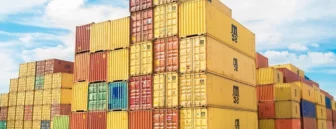COVID-19 has affected all dimensions of business, including warehousing. According to the latest report by Mordor Intelligence LLP, the warehouse services market is expected to grow 10 percent by 2026. Along with demand for warehouse services, customers’ needs are also growing. Customers are demanding more additional services, more transparency in inventory and delivery, and faster delivery times.
To meet customers’ needs, logistics companies have begun to innovate and automate warehouse processes. However, simply introducing technology isn’t enough. Your warehouse should also have a warehouse management system (WMS) that ensures all operations are carried out like clockwork.
But with the advent of innovation and process automation, our clients often run into the problem that existing WMSs can’t cope with their tasks and bring the expected results. If you’re facing this problem, this article is for you. We share the main signs that your WMS needs to be modernized and tips for improving it.
Indicators that you should upgrade your WMS
When a client contacts us with a request to evaluate an existing WMS, most often we identify the following indicators that it’s time for an upgrade.

Inability to meet ever-changing customer needs. As technology advances, customer requirements grow, and warehouse processes get more complex, you might decide to modify your warehouse management processes or provide additional services. However, doing so requires tailored solutions that may either not be available on the market or may not integrate well with your existing WMS, making your business unable to meet all your customers’ needs.
Poor user experience. It often happens that logistics companies use several integrated third-party modules to create an all-in-one system to cover warehouse operation needs. Or companies start to use a WMS that isn’t tailored to their specific warehouse processes and established staff workflow. Both cases lead to frequent human errors and long employee onboarding.
Software rigidity. Most aging logistics software has a monolithic architecture that doesn’t allow the system to scale with additional modules. This significantly hinders your ability to improve warehouse productivity.
Disparate business processes. Most ready-made WMS solutions can’t properly integrate with other systems. The lack of data exchange between systems reduces warehouse efficiency and complicates supply chain operations.
Poor data management. A WMS’s inability to provide real-time data and accurate reporting leads to the inability to identify flaws and ensure proper resource planning. However, if you properly configure your WMS with warehouse equipment and set up data collection channels and analytics, your problems with poor data management will be solved.
Depending on the specifics of your warehouse, the arguments for optimizing your WMS may not be obvious. To understand what exactly is going wrong, at Yalantis, we start by analyzing your existing system to find stumbling blocks to growth. Once we identify them, we come up with solutions. Below, we share common solutions to the above-mentioned problems.
Meet customer needs by expanding your WMS with additional functionality
To apply new capabilities such as for providing additional services, you need to integrate an additional module or functionality into your existing WMS. However, it’s likely that ready-made software solutions tailored to common use cases won’t meet your unique needs. The solution might be developing a custom module to integrate into your WMS.
Below, we give a couple of examples of functionality that’s often developed from scratch. Implementing the first can give you a competitive edge, while the second might help you improve your staff efficiency and operational sustainability.
Value-added services
Value-added functionality enables you to deliver more comprehensive services and is an essential tool for increasing customer satisfaction. Depending on the type of items you store in your warehouse, value-added functionality can be built into any existing module and automate the provision of various value-added services.
For instance, CWI Logistics mostly works with food and beverage suppliers. The company offers a full range of packaging services including assembly, packaging, shrink wrapping, and labeling for any package. CWI Logistics also produces packaging for cold chain products. To deliver uninterrupted value-added services, the company integrated additional functionalities into the product packaging module of their WMS.
Based on your specialization, you can also provide customers with useful additional services. This kills two birds with one stone, enabling your warehouse to cover customers’ real needs, thus increasing customer loyalty, while giving you additional sources of revenue.
Value-added functionality may allow you to automatically select, place, and track shipments for additional services. Besides, your system can automatically include additional service in the billing process so all invoices are transparent and clients see a clear picture of their expenses. To smoothly weave additional services into your WMS, make sure your existing system sends notifications to warehouse managers so they can assign employees to tasks and control their fulfillment.
Management by exception
In an ideal world, warehouse processes run like clockwork. But in reality, unforeseen events may occur requiring immediate intervention. For these cases, you should decide to implement management by exception functionality before unforeseen events occur. Management by exception functionality is often developed on a custom basis since exceptions depend on the type of warehouse, your terms of doing business with your clients, and even the warehouse floor space.
Exceptions that aren’t adequately addressed can have far-reaching implications for the whole supply chain. For instance, for late food shipments, goods may be spoiled and the warehouse held liable. A WMS might detect exceptions in shipment delay and allow managers to set rules and make decisions using exception-based management functionality. The goal of management by exception functionality is to identify situations that deviate from the norm and warn competent managers to fix problems in emergency mode.
Management by exception functionality might be implemented in any module of your existing WMS, such as picking, packing, or inventory. Before implementing this functionality, our experts will study your warehouse processes and determine the most probable unexpected situations so you can quickly handle them using software.
Of course, this isn’t all the advanced functionality that might improve your WMS. Each logistics company has unique characteristics that are sometimes not fully covered by existing WMS solutions. That’s why before determining which additional functionality your system might need, we conduct thorough business analysis and offer a customized solution.
Help users easily adapt to your WMS
Creating a positive WMS user experience requires an individual approach. For instance, if warehouse owners apply several third-party modules to form a WMS system, one solution could be to combine all those modules into a single system and create a single interface from scratch. Besides this, to ensure a smooth transition to new software, it’s important to provide your staff with a familiar user experience.
When a client comes to Yalantis with a similar problem, our experts research all platforms the client previously used. Based on our research, we improve usability of software. For example, if a warehouse manager has to switch from one module to another to dispatch goods (from a cargo picking to shipping module, say), our task will be to make both processes visible on the same screen.
As a result, we not only develop a single unified system that provides users with simple functionality and an intuitive user flow but also provide users with a familiar user experience to ensure seamless onboarding.
As a rule, after a development company combines modules into a single WMS, they must conduct online tutorials and provide user guides to train workers on how to interact with the system.
According to Adrian Kumar, the Head of Operations Science and Analytics at DHL, a unified system is especially important when a company hires temporary employees during seasonal peaks. By passing instructions to new employees, you facilitate the onboarding process and ensure smooth warehouse operations with minimal human errors.
Scale your WMS through a microservice architecture
Your existing WMS may lack the capacity to increase the number of managed modules. This may lead to serious bottlenecks and delays in order fulfillment as your business grows. To avoid this, most logistics companies are abandoning monolithic software in favor of microservice architectures.
A microservice platform is a constructor with a set of functions or modules. The biggest advantage of a microservice architecture is the ease with which you can scale software. Obsolete systems created on monolithic platforms are limited in this regard. Deciding to add a new module to a monolithic WMS will require you to create and deploy a new version of the WMS. This, in turn, requires additional costs and testing. A microservice architecture doesn’t require you to create a new version of your WMS to add new functionality.
With the microservice approach, you can integrate a new microservice into the existing system. Thanks to the flexibility and versatility of this approach, you leave yourself the opportunity to create new functionality or modules at any time.
For a complete picture of how Yalantis implements the microservice platform approach, take a look at the diagram below. A microservice platform consists of many separate blocks (microservices), and if our client needs to add a new block — for example, a goods inventory module — we simply create a new algorithm and then integrate it into the system as a microservice.

A microservice architecture uses APIs to easily integrate with other systems. At Yalantis, we use REST APIs so a WMS can easily integrate with other supply chain systems and bring more value to warehouse operations. Next, we look at the main systems your WMS should integrate with.
Read more about how to create a really great RESTful API
Increase the efficiency of all supply chain operations by integrating your WMS with other systems
By integrating your WMS with other systems, you build a communication bridge and speed up supply chain processes. A WMS integrates with many systems. However, it’s worth remembering that the key systems aligned with your WMS must reflect your business processes. Let’s take a look at the main systems you can integrate with to increase the efficiency of all supply chain operations.
Transport management system (TMS)
A TMS is designed to manage a fleet and all elements associated with it. Integrating your WMS with a TMS lets you fulfill orders with lower transportation costs in a shorter period of time.
Knowing the details of transportation movements, you can optimally plan the shipment or dispatch of cargo that requires careful handling by allocating the necessary number of personnel and equipment. Also, having established supply chain processes, TMS integration lets you respond fast and accurately to unforeseen events like changes in delivery times. Depending on the situation and by having additional information about delivery times, you can make data-driven decisions. Read our case study about how we developed a TMS that can be integrated with a WMS.
Billing system
Invoicing is easier with the ability to integrate your WMS with a billing system. With this integration, data can automatically be transferred from your WMS to any accounting software that you use at your warehouse. Therefore, you can prepare invoices for clients in just a few seconds, allowing you to bill on your own schedule or your client’s schedule without any additional hassle.
Another great advantage of integrating your WMS with a billing system is that if you have hundreds of different clients and each has a different contract rate, you can individually track customer rules such as discounts, special rates, and other unique details.
Labor management system (LMS)
Human labor is often a large percentage of an organization’s expenses. Therefore, a warehouse owner must have efficient workers and a high level of productivity with the lowest possible headcount. LMS systems are powerful tools that allow you to determine the time spent on tasks and the effectiveness of each employee. By integrating your LMS with your WMS, you may increase the productivity of your warehouse operations.
For example, Engineered Specialty Products Inc. (ESP) used warehouse productivity metrics to reduce manufacturing and handling labor by 31.5% while increasing revenue by 22.7%. By rotating workers’ responsibilities, the company has developed average performance metrics. Further, based on these metrics and using the integration of their LMC and WMC, the company introduced a warehouse bonus system.
The bonus system rewards workers who exceed performance metrics and do their jobs well in a certain amount of time. Thanks to the bonus system, some workers began to earn 30 percent more, and the company saw a jump in warehouse productivity.
Ensure better data management by implementing real-time monitoring systems
To be productive, your WMS must not only be able to communicate with other systems but also to operate in real time. One way to adapt data in real time is to integrate all warehouse equipment (sensors, barcode scanners, mini computers) with your WMS via the Internet of Things (IoT). This solution creates a network that collects data, allowing you to make data-driven decisions.
Read also: Why is IoT testing so important?
For instance, DHL warehouses effectively use this approach, and now the company is actively working to ensure that all of their warehouses use IoT systems to provide data to warehouse managers. DHL has set up a perfectly controlled high-tech warehouse. And here’s how technologies work together:
- Objects such as industrial truck computers, wearables, sensors, and surveillance cameras are synchronized with the WMS using the IoT system.
- When a shipment arrives at the warehouse, wireless readers capture the barcode of each pallet. The read data can include product information such as volumes and dimensions, which are then sent to the WMS for processing. Also, surveillance cameras can scan for real-time damage at this stage.
- Based on the received data, the warehouse manager can make a data-driven decision and accurately allocate a storage place for the cargo and decide what to do with any damaged cargo.
IoT not only helps workers make the right decisions but assures your customers that their items are being stored properly. This solution is suitable for cold storage warehouses. You can connect temperature sensors to your WMS to receive temperature data around the clock, and your system can automatically generate reliable metrics and graphs.
After shipping cargo, if there are problems on the client’s side, you might send a report confirming compliance with storage standards. The transparency of warehouse processes increases your customer loyalty and gets customers to come back to you again.
The verdict
As you can see, some of the solutions we’ve described can be implemented by improving your existing WMS. But there are also global implementations like the transition to a microservices architecture that may prompt you to move to a new system. While such a solution takes time to develop and deploy, it’s an investment that will pay off in your warehouse operations in the future. However, keep in mind that it’s best to make upgrade decisions only after consideration and research. Contact us if you would like to receive an assessment of your WMS and determine the most cost- and time-effective solutions to your warehouse problems.
Rate this article
5/5.0
based on 1,121 reviews





